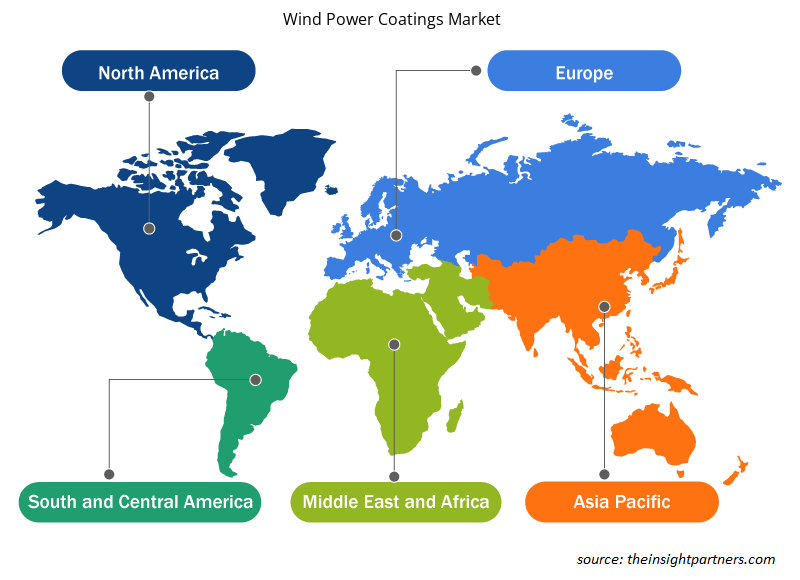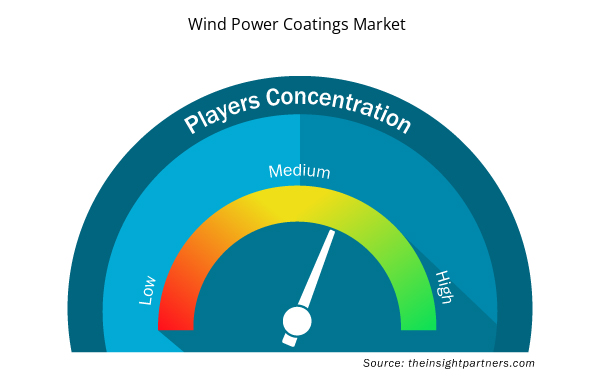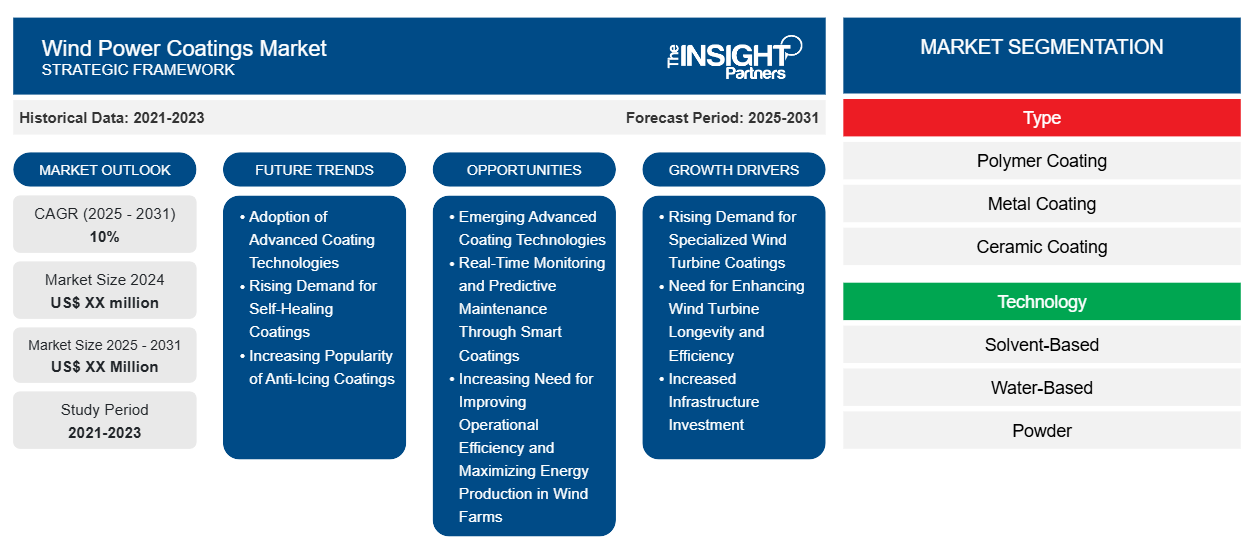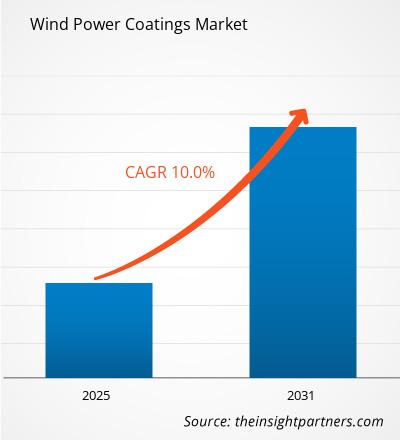Se espera que el mercado de recubrimientos para energía eólica registre una CAGR del 10% entre 2023 y 2031, con un tamaño de mercado que se expandirá de US$ XX millones en 2023 a US$ XX millones en 2031.
El informe presenta un análisis basado en el tipo (recubrimiento de polímero, recubrimiento de metal y recubrimiento cerámico). El informe está segmentado por tecnología (a base de solvente, a base de agua, en polvo y curado por UV). El informe está segmentado por aplicación (palas, torres y otros). El análisis global se desglosa aún más a nivel regional y por países principales. El tamaño del mercado y el pronóstico a nivel global, regional y de país para todos los segmentos clave del mercado están cubiertos bajo el alcance. El informe ofrece el valor en USD para el análisis y los segmentos anteriores. El informe proporciona estadísticas clave sobre el estado del mercado de los actores clave del mercado y ofrece tendencias y oportunidades del mercado.
Propósito del Informe
El informe Wind Power Coatings Market de The Insight Partners tiene como objetivo describir el panorama actual y el crecimiento futuro, los principales factores impulsores, los desafíos y las oportunidades. Esto proporcionará información a diversas partes interesadas del negocio, como:
- Proveedores/fabricantes de tecnología: Para comprender la dinámica cambiante del mercado y conocer las oportunidades potenciales de crecimiento, lo que les permitirá tomar decisiones estratégicas informadas.
- Inversionistas: Realizar un análisis exhaustivo de tendencias sobre la tasa de crecimiento del mercado, las proyecciones financieras del mercado y las oportunidades que existen en toda la cadena de valor.
- Órganos reguladores: Regular las políticas y vigilar las actividades del mercado con el objetivo de minimizar los abusos, preservar la confianza de los inversores y defender la integridad y la estabilidad del mercado.
Segmentación del mercado de recubrimientos para energía eólica
Tipo
- Recubrimiento de polímero
- Recubrimiento de metal
- Recubrimiento cerámico
Tecnología
- A base de disolventes
- A base de agua
- Polvo
- Curado por UV
Solicitud
- Cuchillas
- Torres
- Otros
Geografía
- América del norte
- Europa
- Asia-Pacífico
- América del Sur y Central
- Oriente Medio y África
Geografía
- América del norte
- Europa
- Asia-Pacífico
- América del Sur y Central
- Oriente Medio y África
Personalice este informe según sus necesidades
Obtendrá personalización en cualquier informe, sin cargo, incluidas partes de este informe o análisis a nivel de país, paquete de datos de Excel, así como también grandes ofertas y descuentos para empresas emergentes y universidades.
- Obtenga las principales tendencias clave del mercado de este informe.Esta muestra GRATUITA incluirá análisis de datos, desde tendencias del mercado hasta estimaciones y pronósticos.
Factores impulsores del crecimiento del mercado de recubrimientos para energía eólica
- Demanda creciente de recubrimientos especializados para turbinas eólicas: la energía eólica impulsa significativamente el crecimiento de los recubrimientos para energía eólica. Casi todos los países están avanzando hacia fuentes de energía más limpias, lo que se traduce en una mayor demanda y necesidad de turbinas eólicas, de ahí la necesidad de recubrimientos especializados. Estos recubrimientos protegen las turbinas de dichas condiciones ambientales.
- Necesidad de mejorar la longevidad y la eficiencia de las turbinas eólicas: los recubrimientos de las turbinas eólicas contribuyen a la longevidad y la eficiencia de las turbinas al protegerlas contra la corrosión, la radiación ultravioleta y las inclemencias del tiempo. Esto garantiza que las turbinas funcionen de manera óptima. A medida que se desarrollan cada vez más proyectos de energía eólica en todo el mundo, estos recubrimientos son esenciales para preservar la integridad de las turbinas, lo que impulsa este mercado.
- Mayor inversión en infraestructura: la inversión en el desarrollo de infraestructuras para la energía eólica es significativa debido al aumento de la demanda de energía renovable que ha impactado en áreas como Europa, América del Norte y Asia-Pacífico. Estos continentes han ganado un gran impulso hacia el logro de objetivos de sostenibilidad y reducción de la huella de carbono. Esto también promueve un mercado más amplio para los recubrimientos para energía eólica. El aumento en el número de parques eólicos también hace necesario el aumento de la demanda de recubrimientos diseñados para soportar diversos climas y tensiones operativas.
Tendencias futuras del mercado de recubrimientos para energía eólica
- Adopción de tecnologías de recubrimiento avanzadas: uno de los últimos avances que podría contribuir enormemente a la expansión del mercado de recubrimientos para energía eólica son las tecnologías de recubrimiento avanzadas. A medida que avanza la industria de la energía eólica, la necesidad de recubrimientos para turbinas eólicas para que sean más eficientes y duraderas sigue creciendo. Se están desarrollando recubrimientos para brindar una excelente protección contra la corrosión, el desgaste y el estrés ambiental.
- Demanda creciente de recubrimientos autorreparables: los recubrimientos autorreparables son un importante avance en este campo. Los recubrimientos autorreparables están destinados a reparar ciertos daños limitados por sí solos, lo que prolonga la vida útil de la turbina eólica y reduce sus costos de mantenimiento. Dado que los parques eólicos generalmente están ubicados en regiones remotas, hacer que funcionen de manera más eficiente al reducir el tiempo de inactividad y el mantenimiento hace que este tipo de tecnología sea muy atractiva.
- Creciente popularidad de los recubrimientos antihielo: las tecnologías de recubrimiento para la energía eólica que han encontrado aceptación son los recubrimientos antihielo. Estos recubrimientos funcionan para evitar la acumulación de hielo en las palas de las turbinas para lograr un rendimiento eficaz en condiciones de frío. Como estos parques eólicos se instalan principalmente en regiones más frías, la mayor necesidad será de recubrimientos que mantengan la misma funcionalidad operativa en diferentes entornos.
Oportunidades de mercado para recubrimientos de energía eólica
- Tecnologías emergentes de recubrimientos avanzados: las tecnologías emergentes de recubrimientos inteligentes incorporan capacidades de monitoreo y se espera que presenten un futuro brillante en el mercado de recubrimientos para energía eólica. Los recubrimientos tienen básicamente sensores u otros dispositivos de monitoreo que permiten el seguimiento en tiempo real del estado de las turbinas eólicas. Debido a que los recubrimientos pueden detectar problemas en sus etapas iniciales con grietas o corrosión, mejoran el rendimiento de las turbinas y reducen el tiempo de inactividad.
- Monitoreo en tiempo real y mantenimiento predictivo mediante recubrimientos inteligentes: estos beneficios son muy importantes, considerando las ubicaciones remotas de los parques eólicos modernos. Con datos en tiempo real, las necesidades de mantenimiento se pueden detectar incluso antes de que se vuelvan críticas; por ejemplo, mediante un mantenimiento basado en pronósticos, los operadores pueden monitorear el estado de las turbinas. Finalmente, los tamices ayudan a predecir reparaciones costosas y a extender la vida útil de las turbinas.
- Necesidad creciente de mejorar la eficiencia operativa y maximizar la producción de energía en los parques eólicos: los recubrimientos inteligentes también mejoran la eficiencia operativa en términos de producción de energía. El monitoreo continuo del desgaste de los componentes de las turbinas garantiza que estas funcionen con la máxima eficiencia durante períodos más prolongados. Esto maximiza la producción de energía y también elimina la necesidad de inspecciones repetidas que suelen ser costosas y consumir mucho tiempo.
Perspectivas regionales del mercado de recubrimientos para energía eólica
Los analistas de Insight Partners explicaron en detalle las tendencias y los factores regionales que influyen en el mercado de recubrimientos para energía eólica durante el período de pronóstico. Esta sección también analiza los segmentos y la geografía del mercado de recubrimientos para energía eólica en América del Norte, Europa, Asia Pacífico, Oriente Medio y África, y América del Sur y Central.

- Obtenga datos regionales específicos para el mercado de recubrimientos para energía eólica
Alcance del informe de mercado de recubrimientos para energía eólica
| Atributo del informe | Detalles |
|---|---|
| Tamaño del mercado en 2023 | XX millones de dólares estadounidenses |
| Tamaño del mercado en 2031 | US$ XX millones |
| CAGR global (2023 - 2031) | 10% |
| Datos históricos | 2021-2022 |
| Período de pronóstico | 2024-2031 |
| Segmentos cubiertos | Por tipo
|
| Regiones y países cubiertos | América del norte
|
| Líderes del mercado y perfiles de empresas clave |
|
Densidad de actores del mercado de recubrimientos para energía eólica: comprensión de su impacto en la dinámica empresarial
El mercado de recubrimientos para energía eólica está creciendo rápidamente, impulsado por la creciente demanda de los usuarios finales debido a factores como la evolución de las preferencias de los consumidores, los avances tecnológicos y una mayor conciencia de los beneficios del producto. A medida que aumenta la demanda, las empresas amplían sus ofertas, innovan para satisfacer las necesidades de los consumidores y aprovechan las tendencias emergentes, lo que impulsa aún más el crecimiento del mercado.
La densidad de actores del mercado se refiere a la distribución de las empresas o firmas que operan dentro de un mercado o industria en particular. Indica cuántos competidores (actores del mercado) están presentes en un espacio de mercado determinado en relación con su tamaño o valor total de mercado.
Las principales empresas que operan en el mercado de recubrimientos para energía eólica son:
- Compañía 3M
- Recubrimientos Aeolus
- Akzo Nobel NV
- BASF SE
- Duromar, Inc.
Descargo de responsabilidad : Las empresas enumeradas anteriormente no están clasificadas en ningún orden particular.

- Obtenga una descripción general de los principales actores clave del mercado de recubrimientos para energía eólica
Puntos de venta clave
- Cobertura integral: el informe cubre de manera integral el análisis de productos, servicios, tipos y usuarios finales del mercado de recubrimientos para energía eólica, proporcionando un panorama holístico.
- Análisis de expertos: el informe se compila sobre la base de un profundo conocimiento de expertos y analistas de la industria.
- Información actualizada: El informe asegura relevancia comercial debido a su cobertura de información reciente y tendencias de datos.
- Opciones de personalización: este informe se puede personalizar para satisfacer los requisitos específicos del cliente y adaptarse adecuadamente a las estrategias comerciales.
Por lo tanto, el informe de investigación sobre el mercado de recubrimientos para energía eólica puede ayudar a abrir camino para descifrar y comprender el escenario de la industria y las perspectivas de crecimiento. Si bien puede haber algunas preocupaciones válidas, los beneficios generales de este informe tienden a superar las desventajas.
- Análisis histórico (2 años), año base, pronóstico (7 años) con CAGR
- Análisis PEST y FODA
- Tamaño del mercado Valor/volumen: global, regional, nacional
- Industria y panorama competitivo
- Conjunto de datos de Excel



Report Coverage
Revenue forecast, Company Analysis, Industry landscape, Growth factors, and Trends

Segment Covered
This text is related
to segments covered.

Regional Scope
North America, Europe, Asia Pacific, Middle East & Africa, South & Central America

Country Scope
This text is related
to country scope.
Preguntas frecuentes
Advanced coating technologies is expected to be the key market trends.
Based on geography, Asia Pacific held the largest share of the wind power coatings market, due to the region has been experiencing rapid growth in renewable energy capacity, particularly in wind power. Countries like China and India have heavily invested in expanding their wind energy infrastructure to meet growing energy demands and sustainability goals.
Based on type, the polymer coating segment is expected to witness the fastest growth during the forecast period
The Wind Power Coatings Market is estimated to witness a CAGR of 10% from 2023 to 2031
The global expansion of renewable energy, particularly wind power is driving the market growth.
3M Co; AkzoNobel; BASF SE; Bergolin GmbH and Co KG; Duromar Inc; Hempel A/S; PPG Industries Inc; Teknos Group Oy; The Sherwin-Williams Company; and Thomas Industrial Coatings are some of the wind power coatings market
Trends and growth analysis reports related to Chemicals and Materials : READ MORE..
1. 3M Company
2. Aeolus Coatings
3. Akzo Nobel N.V.
4. BASF SE
5. Duromar, Inc.
6. Hempel
7. Jotun Group
8. PPG Industries, Inc.
9. Teknos Group
10. The Sherwin-Williams Company
The Insight Partners performs research in 4 major stages: Data Collection & Secondary Research, Primary Research, Data Analysis and Data Triangulation & Final Review.
- Data Collection and Secondary Research:
As a market research and consulting firm operating from a decade, we have published and advised several client across the globe. First step for any study will start with an assessment of currently available data and insights from existing reports. Further, historical and current market information is collected from Investor Presentations, Annual Reports, SEC Filings, etc., and other information related to company’s performance and market positioning are gathered from Paid Databases (Factiva, Hoovers, and Reuters) and various other publications available in public domain.
Several associations trade associates, technical forums, institutes, societies and organization are accessed to gain technical as well as market related insights through their publications such as research papers, blogs and press releases related to the studies are referred to get cues about the market. Further, white papers, journals, magazines, and other news articles published in last 3 years are scrutinized and analyzed to understand the current market trends.
- Primary Research:
The primarily interview analysis comprise of data obtained from industry participants interview and answers to survey questions gathered by in-house primary team.
For primary research, interviews are conducted with industry experts/CEOs/Marketing Managers/VPs/Subject Matter Experts from both demand and supply side to get a 360-degree view of the market. The primary team conducts several interviews based on the complexity of the markets to understand the various market trends and dynamics which makes research more credible and precise.
A typical research interview fulfils the following functions:
- Provides first-hand information on the market size, market trends, growth trends, competitive landscape, and outlook
- Validates and strengthens in-house secondary research findings
- Develops the analysis team’s expertise and market understanding
Primary research involves email interactions and telephone interviews for each market, category, segment, and sub-segment across geographies. The participants who typically take part in such a process include, but are not limited to:
- Industry participants: VPs, business development managers, market intelligence managers and national sales managers
- Outside experts: Valuation experts, research analysts and key opinion leaders specializing in the electronics and semiconductor industry.
Below is the breakup of our primary respondents by company, designation, and region:

Once we receive the confirmation from primary research sources or primary respondents, we finalize the base year market estimation and forecast the data as per the macroeconomic and microeconomic factors assessed during data collection.
- Data Analysis:
Once data is validated through both secondary as well as primary respondents, we finalize the market estimations by hypothesis formulation and factor analysis at regional and country level.
- Macro-Economic Factor Analysis:
We analyse macroeconomic indicators such the gross domestic product (GDP), increase in the demand for goods and services across industries, technological advancement, regional economic growth, governmental policies, the influence of COVID-19, PEST analysis, and other aspects. This analysis aids in setting benchmarks for various nations/regions and approximating market splits. Additionally, the general trend of the aforementioned components aid in determining the market's development possibilities.
- Country Level Data:
Various factors that are especially aligned to the country are taken into account to determine the market size for a certain area and country, including the presence of vendors, such as headquarters and offices, the country's GDP, demand patterns, and industry growth. To comprehend the market dynamics for the nation, a number of growth variables, inhibitors, application areas, and current market trends are researched. The aforementioned elements aid in determining the country's overall market's growth potential.
- Company Profile:
The “Table of Contents” is formulated by listing and analyzing more than 25 - 30 companies operating in the market ecosystem across geographies. However, we profile only 10 companies as a standard practice in our syndicate reports. These 10 companies comprise leading, emerging, and regional players. Nonetheless, our analysis is not restricted to the 10 listed companies, we also analyze other companies present in the market to develop a holistic view and understand the prevailing trends. The “Company Profiles” section in the report covers key facts, business description, products & services, financial information, SWOT analysis, and key developments. The financial information presented is extracted from the annual reports and official documents of the publicly listed companies. Upon collecting the information for the sections of respective companies, we verify them via various primary sources and then compile the data in respective company profiles. The company level information helps us in deriving the base number as well as in forecasting the market size.
- Developing Base Number:
Aggregation of sales statistics (2020-2022) and macro-economic factor, and other secondary and primary research insights are utilized to arrive at base number and related market shares for 2022. The data gaps are identified in this step and relevant market data is analyzed, collected from paid primary interviews or databases. On finalizing the base year market size, forecasts are developed on the basis of macro-economic, industry and market growth factors and company level analysis.
- Data Triangulation and Final Review:
The market findings and base year market size calculations are validated from supply as well as demand side. Demand side validations are based on macro-economic factor analysis and benchmarks for respective regions and countries. In case of supply side validations, revenues of major companies are estimated (in case not available) based on industry benchmark, approximate number of employees, product portfolio, and primary interviews revenues are gathered. Further revenue from target product/service segment is assessed to avoid overshooting of market statistics. In case of heavy deviations between supply and demand side values, all thes steps are repeated to achieve synchronization.
We follow an iterative model, wherein we share our research findings with Subject Matter Experts (SME’s) and Key Opinion Leaders (KOLs) until consensus view of the market is not formulated – this model negates any drastic deviation in the opinions of experts. Only validated and universally acceptable research findings are quoted in our reports.
We have important check points that we use to validate our research findings – which we call – data triangulation, where we validate the information, we generate from secondary sources with primary interviews and then we re-validate with our internal data bases and Subject matter experts. This comprehensive model enables us to deliver high quality, reliable data in shortest possible time.


 Obtenga una muestra gratuita de este informe
Obtenga una muestra gratuita de este informe